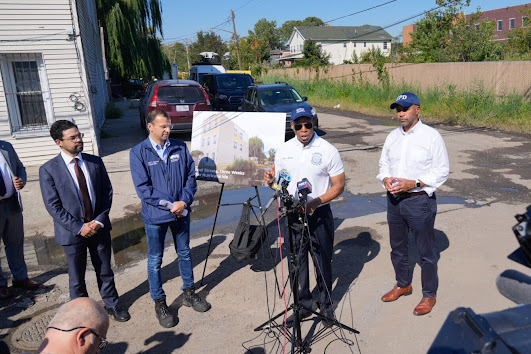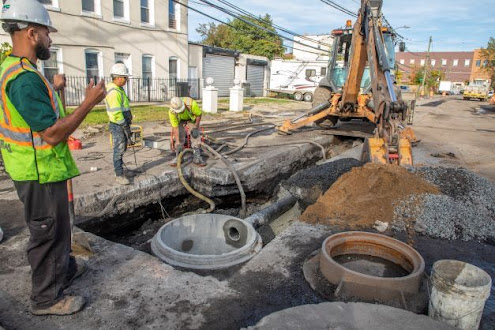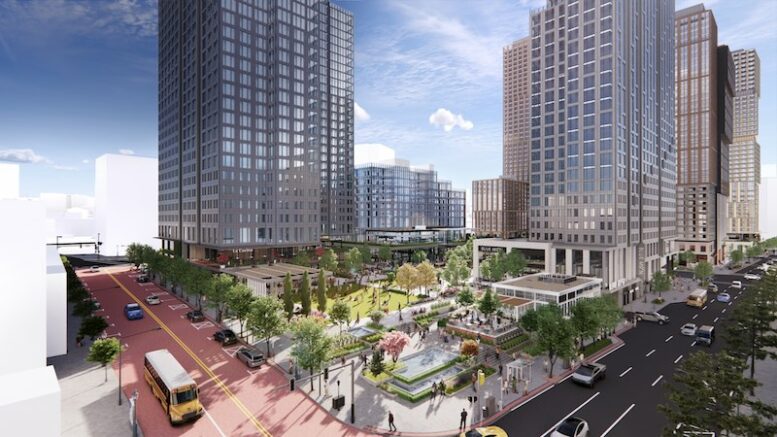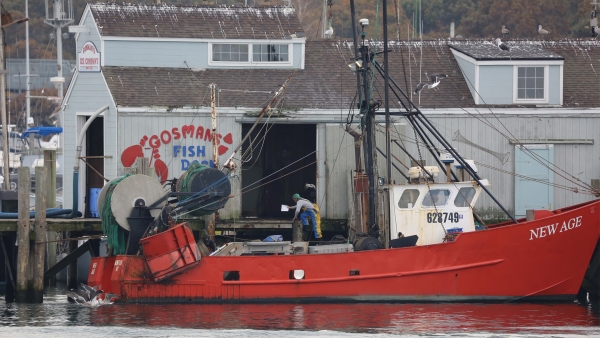Neighborhood Suffered from Chronic Flooding, Disinvestment for Decades
Infrastructure Improvements Completed in March 2023 Helped Alleviate Flooding as Much as 10 Times Faster Last Week Than After Hurricane Ida
Adams Administration Has Expanded Drainage Capacity, Launched “Jewel Streets Neighborhood Plan” to Upgrade Resiliency Infrastructure and Create Affordable Housing
New York City Mayor Eric Adams today visited the Jewel Streets neighborhood — also known as “The Hole” — in Queens and Brooklyn to evaluate flooding impacts and resiliency infrastructure following extreme rainfall this past Friday. Joined by Chief Climate Officer and New York City Department of Environmental Protection (DEP) Commissioner Rohit T. Aggarwala, New York City Department of Housing Preservation and Development (HPD) Commissioner Adolfo Carrión Jr, Mayor’s Office of Climate and Environmental Justice (MOCEJ) Executive Director Elijah Hutchinson, and the New York City Department of Transportation, Mayor Adams inspected new sewer infrastructure installed by DEP between September 2022 and March 2023 that helped alleviate street flooding from Friday’s storm in a matter of hours instead of weeks, as was the case after a similar volume of rain fell during Hurricane Ida in 2021.
Following Mayor Adams’ visit, HPD and DEP tonight are hosting a community workshop as part of the Adams administration’s Jewel Streets Neighborhood Plan process to discuss climate risks, including flooding, as well as the future of a vacant, city-owned site on Stanley Avenue that could become home to affordable housing, community amenities, and open space. The workshop will take place at P.S. 218 between 6:00 PM and 8:00 PM. The Jewel Streets is a 12-block neighborhood that straddles East New York in Brooklyn and Lindenwood in Queens. Because the neighborhood is a low-lying area without comprehensive stormwater and sanitary sewer infrastructure, residents experience year-round flooding, even on sunny days.
“For decades, the Jewel Streets neighborhood has been abandoned, left to suffer chronic flooding, even on sunny days. We have been clear that that is no longer the case in this administration,” said Mayor Adams. “Our administration was ahead of last week’s flooding with critical, initial investments to improve infrastructure and clear the streets as much as 10 times more quickly than after Hurricane Ida. But this is just the beginning: We’re investing $75 million in a comprehensive plan to improve quality of life for residents of the Jewel Streets with resilient infrastructure, affordable housing, and new economic opportunities.”
“The harsh impacts of flooding were especially acute here, but sadly and more importantly, flooding in general is part of residents’ daily experience. That is unacceptable,” said Deputy Mayor for Operations Meera Joshi. “While DEP’s installation of a sewer line last year did help minimize the recovery time, it’s clearer than ever that we need a robust and resilient design done in a timely manner for this community. Continuing with tonight’s community meeting, we are advancing the Jewel Streets Neighborhood Plan process and improving quality of life for the members of this community.”
“At DEP, we are both implementing short-term solutions and advancing long-term infrastructure investments to make communities like the Jewel Streets neighborhood more resilient. Friday’s severe rainstorm was the direct result of climate change, but thanks to the upgrades made to the area’s drainage network in March, the streets are not experiencing the prolonged flooding that frequently occurred at problematic intersections,” said Chief Climate Officer and DEP Commissioner Aggarwala. “New York City is investing billions of dollars to better manage extreme weather, and our engineers will continue to work with residents and partner agencies to inform our citywide strategies to address intense rainfall events.”
“Time and time again, we say that New Yorkers deserve better, but past administrations fell short in the Jewel Streets,” said HPD Commissioner Carrión. “When we talk about investing in the Jewel Streets, what we’re really talking about is treating Black and Brown New Yorkers with dignity and respect. I stand here today, along with Mayor Adams, to change that now. Today marks a step forward and a renewed commitment to deliver infrastructure solutions, build more affordable housing, and create a better, safer, and more resilient quality of life for the Jewel Streets community.”
“Last week’s storm showed us once again why it is critical to undo the legacy of disinvestment from underserved communities,” said MOCEJ Executive Director Hutchinson. “New York City has the most ambitious climate agenda in the United States, and we cannot meet our goals without bringing everyone along. We look forward to working with residents and our agency partners to creatively think of infrastructure solutions that will address flooding issues like we saw on Friday and into the future.”

Mayor Eric Adams (center), HPD Commissioner Adolfo Carrión Jr. (right), DEP Commissioner Rohit T. Aggarwala (left), and MOCEJ Executive Director Elijah Hutchinson (far left) discuss street flooding alleviation in the Jewel Streets neighborhood in Brooklyn and Queens. Credit: Ed Reed/Mayoral Photography Office.

New York City Department of Environmental Protection workers constructing drainage upgrades in the Jewel Streets neighborhood in October 2022. Credit: New York City Department of Environmental Protection
From September 2022 to March 2023, DEP completed infrastructure upgrades to the storm sewer system, increasing drainage capacity and helping to better manage stormwater. New storm sewers and catch basins at problematic intersections identified by the community and DEP engineers significantly reduced chronic flooding caused by the area’s low elevation, which creates a bowl that previously collected rainwater.
As a result of that initial investment, street flooding caused by the approximately seven inches of rain that fell on Jewel Streets during last week’s storm eased within hours and dissipated completely within two days. In contrast, Hurricane Ida also deposited approximately seven inches of rain on the neighborhood, but street flooding and ponding lingered for weeks.
In June 2023, Mayor Adams kicked off the Jewel Streets Neighborhood Plan, an effort to deliver much-needed quality of life improvements — including infrastructure improvements to alleviate flooding as well as new affordable housing — to the area. Backed by more than $75 million in initial funding, the Adams administration’s planning process aims to bring resiliency measures to this chronically flood-prone area, improve street infrastructure and pedestrian safety, and create new, affordable housing and economic opportunity for residents of this community that has long suffered from flooding and been deprived of public investment.
The Adams administration has kicked off a holistic community planning process where residents will be able to weigh in on a series of tools to address flooding, including a bluebelt and a drainage pond to divert rainwater from sewers; green infrastructure, like rain gardens to provide additional capacity to absorb rainwater; upgraded sewers with expanded capacity to serve as the first line of defense against flooding from rain events; and additional supportive tools, such as raised streets. Community members will also have an opportunity to share perspectives on ways the city can make streetscape upgrades to improve safety and connectivity to nearby neighborhoods, create affordable housing on city-owned land, stimulate the creation of good jobs and community amenities, and develop a long-term land use and zoning plan.








